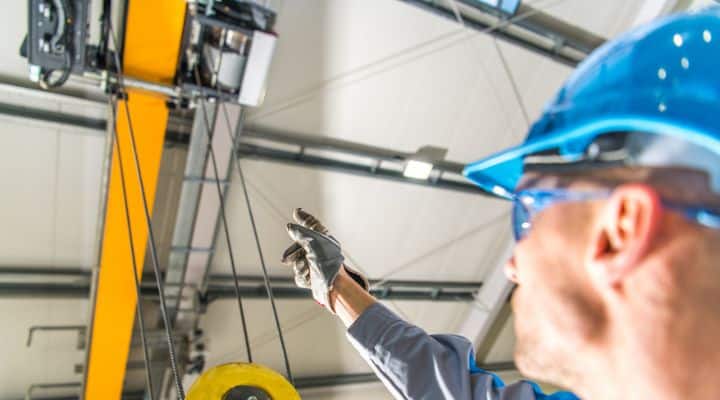Operational productivity is maximized, total repair costs are reduced, and safety of your equipment is optimized when you have implemented the proper inspection and maintenance frequency for your overhead cranes and hoists.
The big question is: How do I know what is the proper frequency?
Worker safety is an obvious priority for every business, so the minimum frequency of inspections must ensure that equipment conditions are monitored frequent enough to ensure safety. If your cranes are always safe, you also reduce employer liability and potential OSHA compliance issues – beyond worker safety.
The priority of equipment operational cost and productivity vary in importance from one business to another. Lost production time from out of service crane equipment can cost some businesses tens of thousands of dollars per hour; while for others, it is only a minor inconvenience. Inspections that identify deficiencies that allow for planned repairs and subsequently reduce or eliminate crane-related unplanned downtime can be great investments in a production-critical business.
A great crane and hoist inspection program starts with properly trained and qualified inspectors taking enough time to thoroughly inspect all the equipment components that could be deficient and might contribute to a future safety incident or unplanned breakdown. Great Inspectors are not enough; you have to implement a schedule of OSHA “Frequent” and “Periodic” inspection that is frequent enough to hopefully catch problems before they lead to a safety or production incident. So, it is critical to understand the equipment in your facility and the factors that contribute to inspection frequency.
Those factors are:
- The propensity of the equipment to break down: This factor is heavily influenced by use, the age of the equipment, maintenance history, and maintained condition of the equipment.
- The use of grabs or lifters. These cranes are always under load and excess wear.
- The intensity of use: Equipment used continuously over three shifts each day will see far greater wear and tear. Cranes lifting at or near capacity are working harder.
- The environment: Equipment in a hostile environment including severe heat, moisture, cold, dust, or chemical exposure will see added stress and deterioration of structural, mechanical and electrical components.
- Operator training: Poorly trained operators will likely cause increased stress on the equipment by jogging the motion and violating conservative operating practices.
One of the best methods to gauge the effectiveness of crane inspection frequency is to routinely examine the number and severity of safety and operational deficiencies that crop up in the time frame from the last “Periodic” inspection to the most recent. If you are performing “Periodic” inspections every 3 months and you have 1 or fewer safety or repair deficiencies than your current program is likely sufficient. If your cranes each routinely have more than 2 or more within a given time frame, then we would recommend decreasing the “Periodic” inspection period so that you have no more than an average of one newly found serious deficiency in the interim period.
Review the service manuals for the crane and hoist; note both the recommended service and maintenance intervals. Never increase your intervals beyond that of the manufacturer’s requirement for both safety and liability sake.
OSHA designated “Periodic” inspections (Monthly to Annual) are very thorough and should catch all of the visible deficiencies. OSHA designated “Frequent” inspection (Weekly to Monthly) are visual and operational. These are partial inspections designed to catch really serious issues that might crop up in between the much more comprehensive “Periodic” inspections.
In a Periodic Inspection, the Inspector must access the equipment using a lift or the crane walkway to review the condition of mechanical, electrical and structural elements of the crane and hoist. Control panels are opened; mechanical components such as drums, wheels, sheaves, and couplings are reviewed for wear; breaks are checked for wear and adjustment, and gearboxes checked for oil level.
The great thing about proper crane and hoist inspections is that the cost is relatively small in comparison to the benefits of increased safety and the reduction of unplanned downtime costs. So more is better. We find businesses that perform “Periodic” inspections on a monthly frequency have the fewest safety problems and breakdowns.




